#jeronimos monastery
Explore tagged Tumblr posts
Text
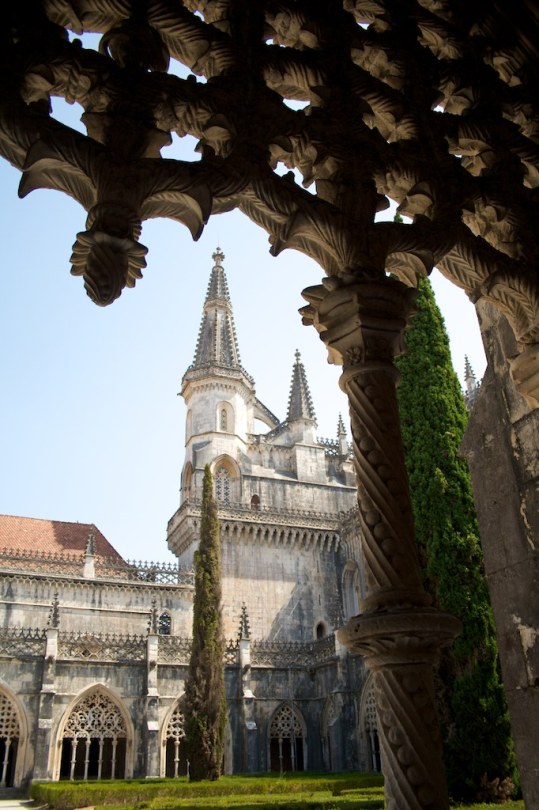
Jeronimos Monastery, Portugal (by mas.si)
2K notes
·
View notes
Text


2 notes
·
View notes
Text






.
Monteiro dos Jerónimos
The Jerónimos Monastery is one of the most prominent examples of the late Portuguese Gothic Manueline style of architecture in Lisbon. It was erected in the early 1500s near the launch point of Vasco da Gama's first journey.
The construction of the monastery and church began on 6 January 1501, and was completed 100 years later. King Manuel originally funded the project with money obtained from the Vintena da Pimenta, a 5 percent tax on commerce from Africa and the Orient, equivalent to 70 kilograms (150 lb) of gold per year, with the exception of those taxes collected on the importation of pepper, cinnamon and cloves, which went directly to the Crown.
The monastery was designed in a manner that later became known as Manueline: a richly ornate architectural style with complex sculptural themes incorporating maritime elements and objects discovered during naval expeditions, carved in limestone
4 notes
·
View notes
Text
Explore the exciting highlights of Lisbon and Sintra on a four-day self-guided tour
There are so many ways to travel these days, and though I’ve tried and enjoyed many of them, I always come back to my favorite – self-guided, walking trips, where I get to make the decisions and can move at my own pace. These types of vacations often take a lot of planning and research, especially when going abroad. The planning is part of the fun, but I learned that having some assistance in…

View On WordPress
0 notes
Text

Sun over Jeronimos Monastery
#jeronimos#monastery#sunset#photographers on tumblr#original photographers#portugal#landscape#photography#architecture#gothic#Manueline
26 notes
·
View notes
Text

Monastery of Jeronimos, Lisbon, PORTUGAL
79 notes
·
View notes
Text









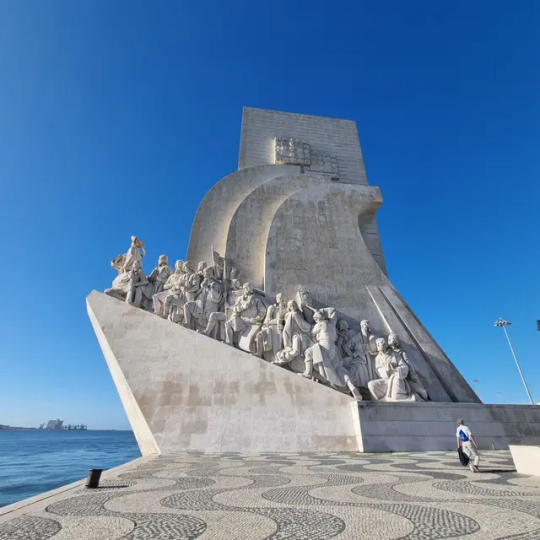
21/12/2023 - Breakfast P2
🇵🇹 Pastéis de Belém, Lisbon
🥚 Pastel de Belem (€ 1.30, $1.90)
Not as nice as I remembered. They don't heat it up when they serve it ):. Still has that very crispy pastry and the filling is definitely less sweet and more to our liking.
🦆🥧 Duck and Spinach Pie (€2.20, $3.21)
Was tasty enough but could have more filling.
Featuring Jeronimos Monastery - very pretty place, it's cathedral and the monument of discoveries
0 notes
Text

0 notes
Text










Jeronimos Monastery, Lisbon
19 notes
·
View notes
Text



Princess Leonor, The Princess of Asturias attends a Floral Tribute at the tomb of Luis de Camoes during her official visit to Portugal, at the Jeronimos Monastery in Lisbon, Portugal -July 12th 2024.
#princess leonor#princess of asturias#spanish royal family#spain#2024#july 2024#royal visit portugal#royal visit portugal 2024#portugal 2024#portugal#royal children#my edit
10 notes
·
View notes
Text




Through the Years → Felipe VI of Spain (3,007/∞) 9 May 2023 | King Felipe VI of Spain greets children upon his arrival at the XVI edition of the 'Carlos V European Award', at the Monastery of San Jeronimo de Yuste, in Cuacos de Yuste, Caceres, Extremadura, Spain. The Charles V European Award was presented to the Secretary General of the United Nations, Antonio Manuel de Oliveira Guterres for his work at the head of the international organization in promoting "actions to respond to the Covid-19 pandemic, to the war in Ukraine, to address the climate emergency and to achieve ambitious reforms to meet the challenges of the 21st century". (Photo By Jorge Armestar/Europa Press via Getty Images)
3 notes
·
View notes
Text


3 notes
·
View notes
Text
Fun and/or delightful things said by my assorted tour guides during this trip to Lisbon:
After I asked if people study Spanish in school in Portugal: “No, it's too close to Portuguese. Of course, we all think we can speak Spanish, but we can't.”
During our food tour (with Devour btw, highly recommended in any of the cities they do tours in!), our half Italian, half Ethiopian tour guide who’s been living in Lisbon for a decade: “I don’t know why the Portuguese don’t eat vegetables. They have them. And yet on the menus it’s all meat and fish.”
(This dude also gave us the A++++ tips of: enter the Livraria Bertrand via the cafe entrance on the side, much less crowded, and visit the Estufia Fria, which was a truly lovely and surprisingly big botanical garden. A quiet and peaceful respite during the trip!)
(Also, this dude’s tragic backstory: half Italian, and allergic to tomatoes :( Though he did constantly shit talk Italian food for being too boring and set in its ways lol.)
When we got to the big market with fresh fruits and veggies: “See, they have vegetables!”
About all the explorers and colonizers etc: “You know, they say these guys did it all for the glory of Portugal, but come on! They did it for the money!” (Appreciated that this guy also mentioned, hey, we have all these monuments about the Age of Discovery, but none memorializing its evils and horrors.”)
Dueling opinions about the pasteis de nata: food tour guy said Manteigaria has the best (though he allowed that Castro’s were pretty good too), other guide said the originals in Belem are the best. First tour guide said forget about pasteis de nata, Sintra’s pastries are where it’s at.
Coolest sights:
Unfortunately, the major parks and sights in Sintra were closed due to wildfire risk. It was still neat to visit the town though!
Cabo de Roca, the westernmost point of continental Europe was a surprisingly neat stop on one of our tours. Super windy, but neat to say you’ve been there.
The Jeronimos Monastery. Should you ever go, I really recommend booking a tour if only to skip the longest line, because holy shit that line was enormous. Anyway, the Manueline architecture is gorgeous.
Igreja de Sao Domingo. Fascinating story and interior. We stopped in during our food tour, and it’s so interesting to see the building’s history of disaster and reconstruction written on it so plainly.
The enormous Time Out Market that houses curated restaurants in a food court setting one one side and a traditional market on the other is just super neat and it’s worth it just to take in the atmosphere.
The MAAT museum was fine, but tbh, the view of the Tagus River and statue of Christ Redeemer from their cafe was lovely. Worth eating a light meal or having a coffee here and just relaxing!
God I wish we had a culture of nice, big public squares with great architecture and plenty of cafes and benches in the US. I know there are some on the East Coast, but here on the West Coast, we just have the occasional little park :( Every single such square we saw in Lisbon was lovely.
The Estufia Fria, as mentioned above.
The National Tile Museum! Sounds boring, but it was both interesting and super impressive.
Gulbenkian Museum. Now this is how insanely rich dudes should spend their money: collecting massive amounts of art and then putting it all on display in a museum in perpetuity after their deaths. Great collection of Egyptian, Near Eastern, Chinese, Japanese, and European art, plus a stunning though small-ish Lalique collection.
Mostly though we just wandered around, which is honestly my favorite thing to do in a new to me city, and while the hills are punishing, Lisbon is a great city to wander in.
Most delicious things I ate:
Gotta agree with food tour guy, it was the Mantegiaria pasteis de nata for me.
Meat sushi??? It was cooked, but it still felt like a great sushi innovation.
Chocolate cake from Landeau. Life-ruiningly good. All other chocolate cakes will pale in comparison.
Some astonishingly good Indian/Nepalese food, somewhat surprisingly. Some of the best naan I’ve ever had, and their dishes were presented so beautifully. Like, I like Indian food just fine in America! It’s basically always tasty! But this was on another level, and still comparable in price to the nicer Indian restaurants in the States.
Some of the best roasted chicken I’ve ever had in my life. Very simply prepared, but so tender and tasty.
Ate at one (1) fine dining restaurant, and damn, okay, that’s what the prices are about. I had duck breast and the dish as a whole was just exceptional.
Some very good gelato at the packed and bustling Time Out Market. Such a cool spot, I honestly wish every city had a version of this. (I know LA kind of does, but I like that the Time Out Market is curated.)
At the other end of the spectrum, a suspiciously cheap restaurant near our hotel that nonetheless had phenomenal food. Straightforward Portuguese with a twist food, presented beautifully with pretty generous portion sizes. Seriously though, it was so cheap I actually felt kind of guilty about it. Also they were cash only?? And had weird hours?? So maybe it’s a front? But the hotel recommended it and they’ve been in business for 50 years! So whatever, if it is a front, thank you to whatever mob boss is supporting their relative’s culinary dreams. Anyway, best chocolate mousse and sangria I’ve had to date, and the mains were good too. Truly felt like we got away with something eating mains, drinks, and dessert for two for 36 euros.
Our hotel brought us fresh pastries for breakfast every morning, and the chocolate croissants were especially delicious.
Okay, I know ginjinha is traditional and all here, but. Listen. It tastes like especially alcoholic cough syrup. (The booze-soaked cherry included in the shot glass was good tho) The white wine port I had at the suspiciously cheap restaurant, on the other hand, was absolutely delicious.
3 notes
·
View notes
Text
Madrid Week 3: Flashbacks
Hola a todxs! It’s Niko back with week 3 of studying abroad in Madrid. Time is STILL passing by really fast and slow at the same time, so I'll talk about it again — I’ve been here less than a month and it’s felt like half a year, but the days go by quickly. I don’t think that will stop anytime soon, but I’m here for it. More perceived time = more life lived, and I hope that my weeks don't start blending together anytime soon.
As promised in week 2, I wanted to spend this blog talking about my trip to Granada last weekend. Granada is a small Spanish town in the southern region of Spain called Andalucía. It’s got a population of around 230,000 people — nearly the exact same as my hometown of Arlington, VA, which is a suburb outside of Washington, DC. However, in place of tree lined residential neighborhoods and modern office buildings, Granada is filled with narrow cobblestone streets bordered by low, densely packed buildings and intensely intricate churches/palaces built hundreds of years ago.
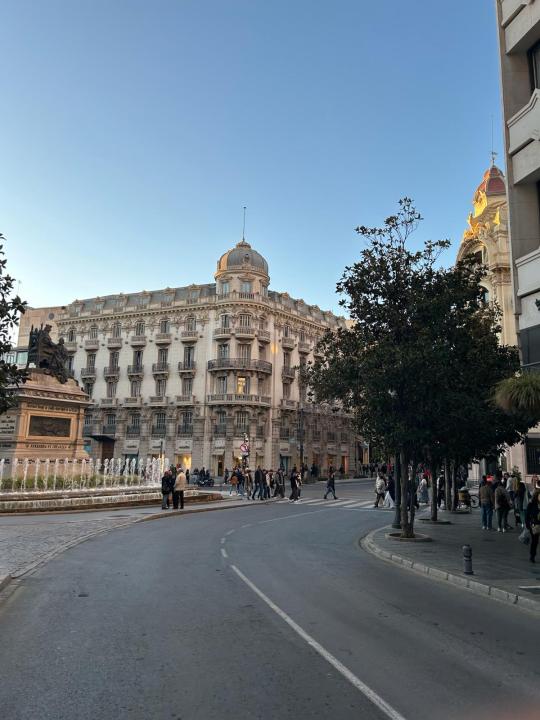
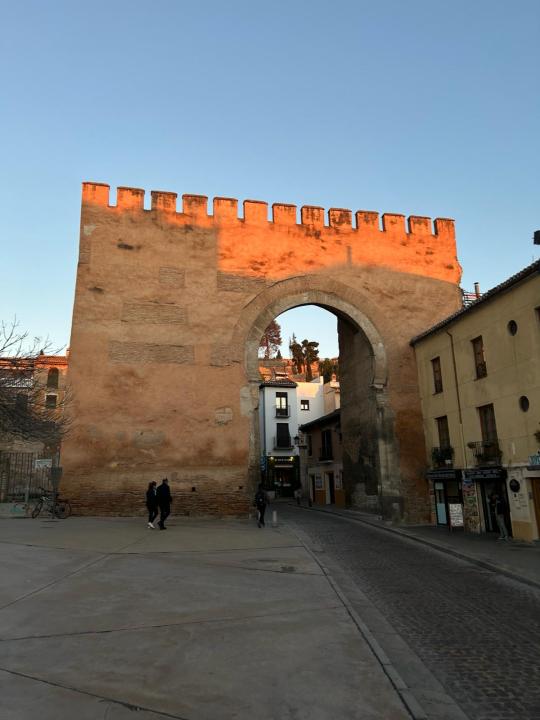
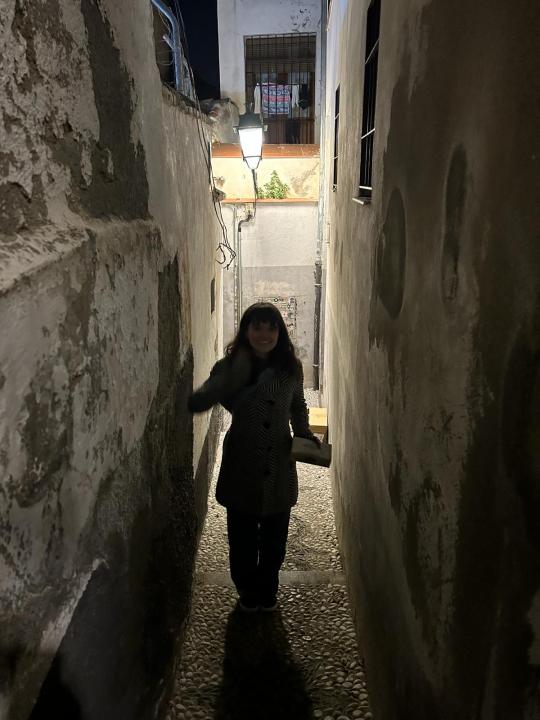
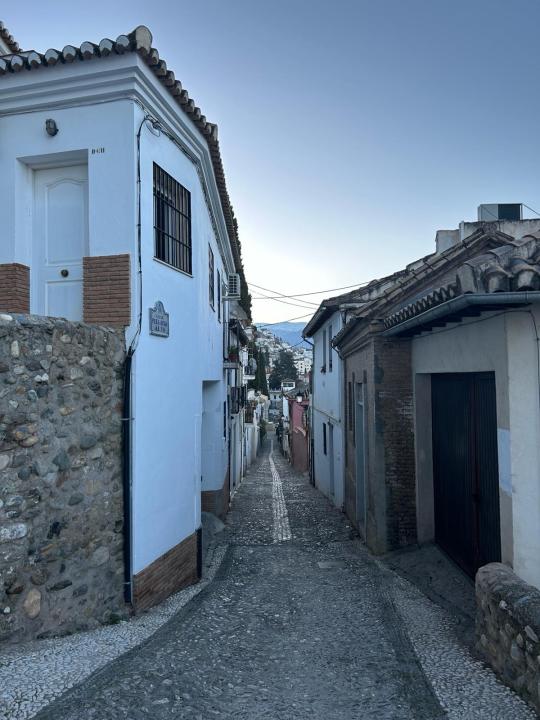
That palace — La Alhambra — is the largest tourist attraction in Granada, and was one of the main reasons I wanted to visit it (also, a big shout out to Emma for hosting me, a friend of mine from high school doing her semester in Granada!!). It’s a massive Moorish palace on a hill that overlooks the entire city. The Moors, who were North African Muslims, conquered much of the Iberian Peninsula in the 8th century. La Alhambra was slowly built between the years 1238 and 1358, during the reigns of Ibn al-Aḥmar and his successors.
With that said, my trip to Granada last weekend was not my first time seeing La Alhambra. As I mentioned briefly in week 0's blog, I took a trip to Spain with my 8th grade Spanish class for a week. That was 7 years ago. We hit most of the main touristic Spanish cities within that time, Granada included.
So, walking through the palace last weekend triggered a slow trickle of distant memories, fuzzy enough that I couldn’t remember details, but potent enough that I could remember how I felt. Some things had changed about the palace, many things stayed the same. I still felt the same sense of awe I did 7 years ago witnessing the incredible detail hand-carved into every surface, or seeing the palace perfectly reflected in a courtyard’s pool. The difference was that this time, I was exploring alone.
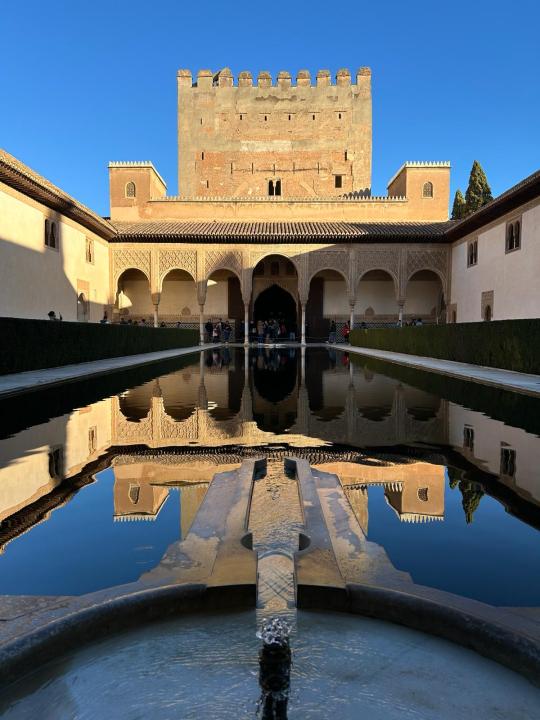

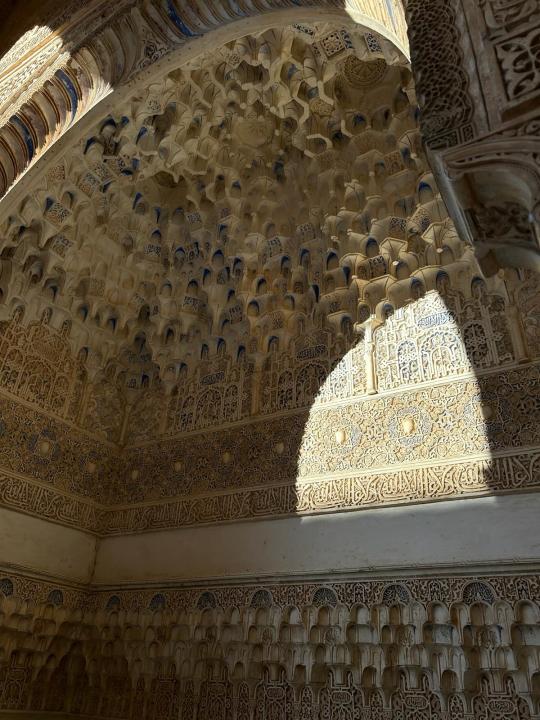
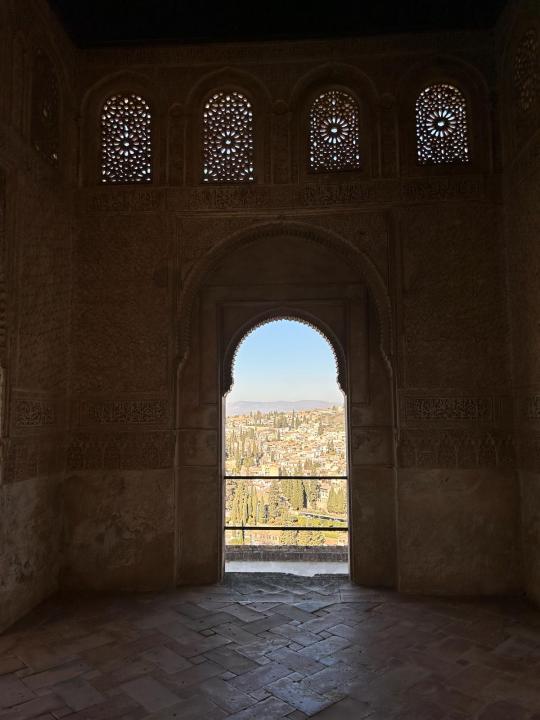
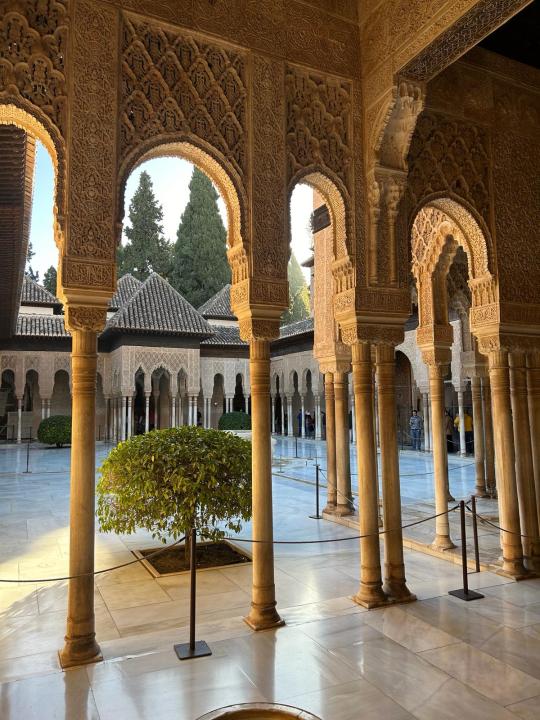
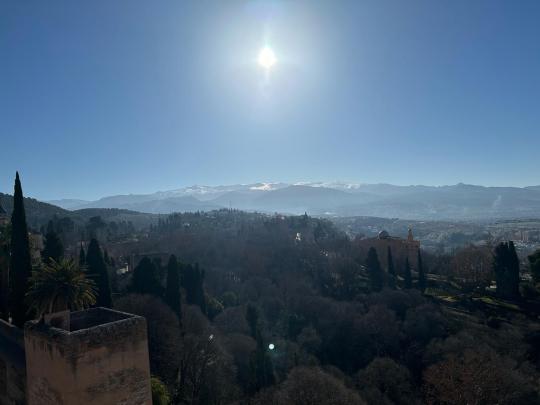
I think that during this trip, I really gained an appreciation — and curiosity — of solo travel. Although I was with my friend Emma much of the time, I felt a great deal of peace in exploring La Alhambra at my own pace. Without anyone else to turn to, I was forced to be present and attuned to my surroundings, and that enabled me to appreciate them that much more.
I think that part of that appreciation, however, was derived from the sense of independence and freedom I had existing alone in Granada. Going into college, being alone terrified me. I would step into the dining hall for lunch and wander through the common spaces, looking for a familiar face I could share a meal with. Now, I try my best to cherish the moments in which I can connect more to myself, whether that be during a meal, practicing a hobby, or exploring an ancient Moorish palace. That’s only something I've been able to move towards through consistent practice -- AKA, spending deliberate time alone. I hope to continue deepening that connection throughout this semester solo-exploring Spain and Europe, which I know is something I'll carry with me for the rest of my life.
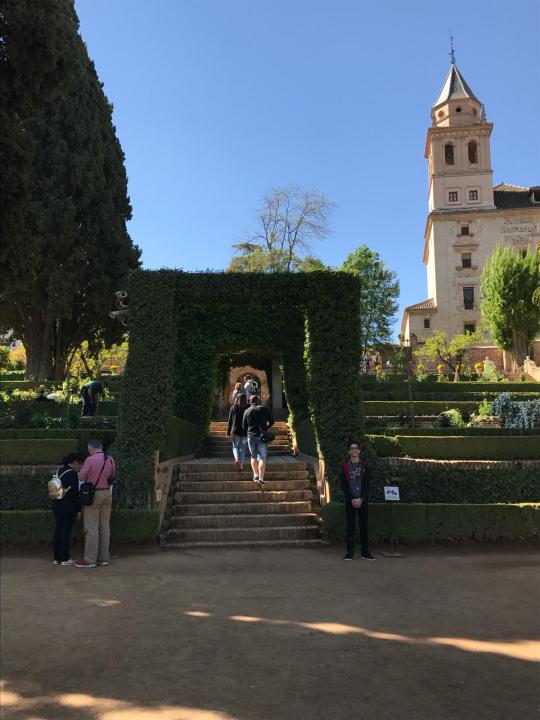
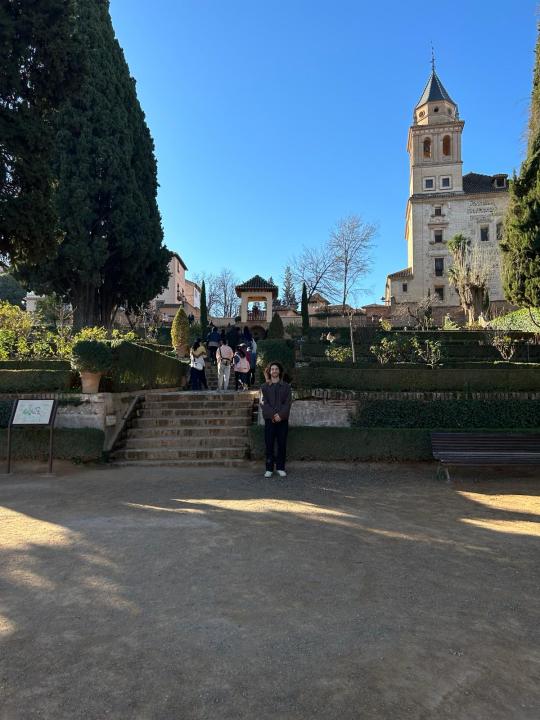
Aside from La Alhambra, Emma and I explored the city and its various landmarks (El Albaicin, a predominantly Muslim neighborhood, the Granada Cathedral, the Monastery of San Jeronimo, the Mirador de San Miguel Alto [and an epic sunset], and even a jazz-esque show with Spanish flair from a band at a local music club). More pictures below.
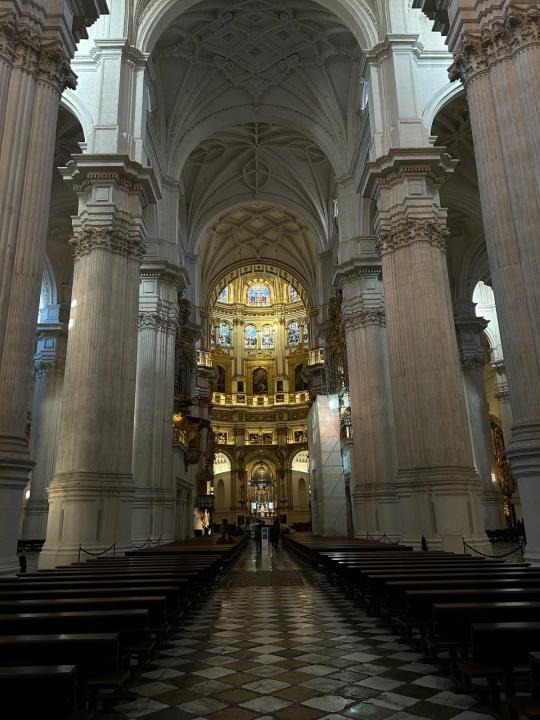
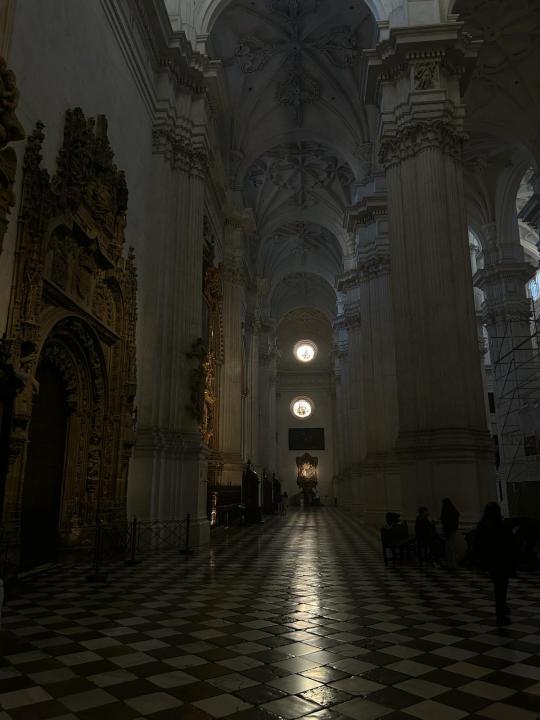
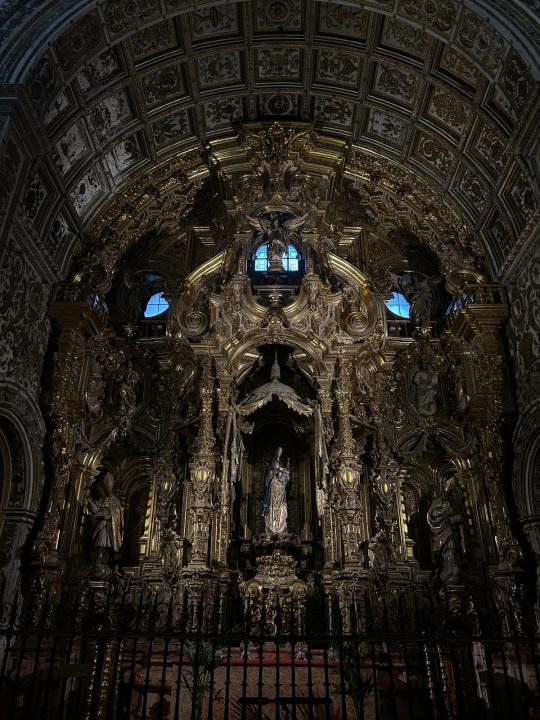
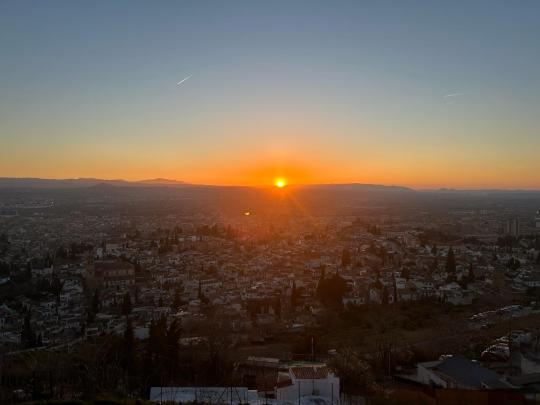



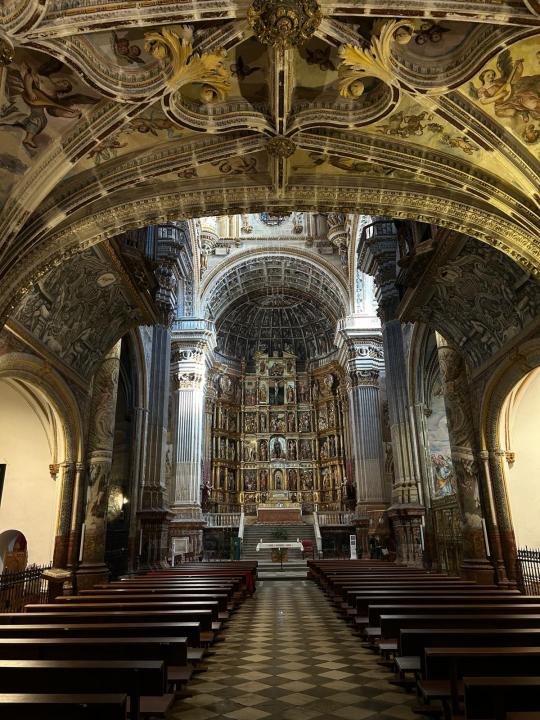
On the way back home, we stopped at a rest stop for the bus, and I couldn’t help but notice how familiar it seemed. It conjured up a nostalgic feeling that could have only come from my first trip in Spain — I realized we had stopped at the same station.
For old time’s sake, I bought a Kinder Egg Sorpresa. These things were a huge deal to me in 8th grade, as they are banned in the USA for being a ‘choking hazard’. Inside the chocolate exterior was a little plastic goat toy that will now serve as the centerpiece of our dining room table.
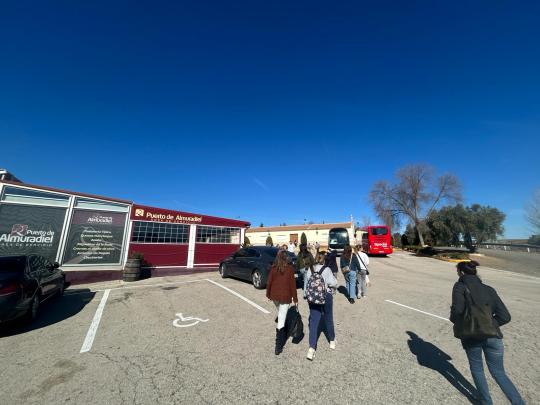
It’s funny to think how much of a different person I am from the 13 year old on vacation with his school friends and Spanish teachers. But it’s also comforting to know that all of these memories I carry with me explain the person I am today.
This week, I got a little more into school groove, took a rollerblading route, visited the Reina Sofia museum and went to see some amazing techno DJs over the weekend. Per usual, check out the photo captions for more info on the content this week :).
Hasta luego,
Niko Economos
Aerospace Engineering
Universidad Carlos III de Madrid
Madrid, Spain
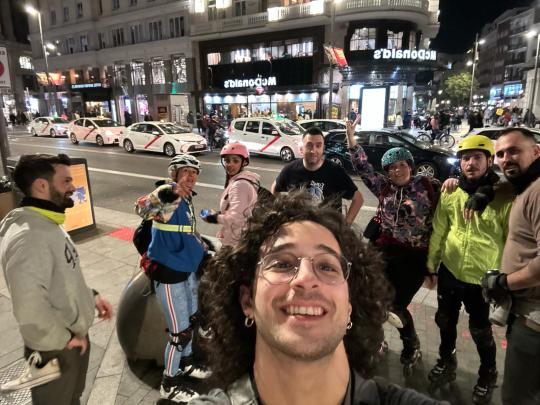
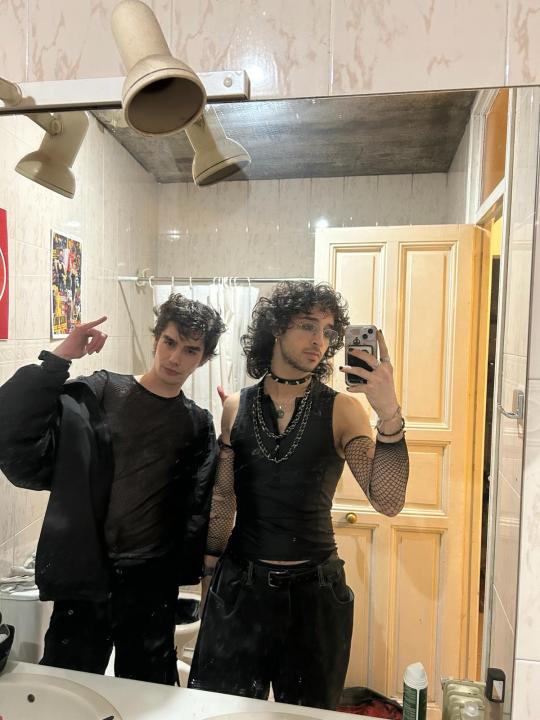

4 notes
·
View notes
Note
Oh, that Jeronimos gossip sounds interesting. What do you mean, it was a scandal?
In the 19th century, everyone in Europe was traversing an identity crisis and sought to define their own nationalism. So nations in europe looked back at their past and tried to think, which moment of the past signified our biggest glory? The answer to this question is whatever revival you see in the country's capital city. Paris with Gothic. England with Tudor. Greece is easy to answer. Italy, take a guess.
Well we realised, it has to be Manuel I, because that's when we were an EmPiRe. Glorious constructions! Colonialism! Imperialism!
More so, at this moment, and this when the subject of Art History is being developed into a field of studies and not just an "I have opinions" type of thing, people figured it was at this moment that Portugal, because it had so much money, developed its own style. A style uniquely portuguese, an architectural language that willingly (willingly!) rejected the renaissance, which could only mean we were SO POWERFUL. A style that is comprised of all these new ExOtIc things we were discovering across the globe, and which apparently celebrates the discoveries because wow look at all these ropes on these windows!
On a side note: now that we're in 2023, that is 90% false. Most art historians disagree that Manuelino is an architectural style at all. The "ropes" are not ropes and never were. There is some "exoticism" in the buildings, yes, but they're not there because "haha white man never seen an elephant before". They're actually symbols of power and they're documents of events that happened in history. Fun stuff, but as usual, the romantics were wrong.
So with this settled among the portuguese people, everyone decided we must find the most glorious example of this architecture! And hey! We have it! It's the Jeronimos Monastery! The greatest gem of Manuelino!
Just one problem.
In the 19th century, the monastery was in ruins.
In 1833, religious orders were annhiliated off the face of this country, for several reasons that to this day bother the shit out of historians, but the fact of the matter is that we have a fuckton of them, way to fucking many, and they're been hoarding shit like fucking dragons. To give you an idea, there was so much shit (and I mean art, jewellery, paintings, sculpture, etc) that entire wings of the National Museum of Ancient Art were FILLED with just the crap found inside these convents.
The Jeronimos Monastery was one of the many shut down, the monks then had to go elsewhere (which is when they sold the recipe for the custard tarts of Belém to the store that is still today, and why it is still a secret). Soon after, the Monastery became home to Casa Pia, which is kind of like an orphanage for the non-portuguese people.
When this debate was happening, the monastery was in near-ruins. I mean, completely run down. So it was a huge shame at the time.
Now, mind you, this is the kind of debate that the average Zé doesn't give a shit about, and at the time, the government wasn't really concerned about this.
Enter Alexandre Herculano, and Almeida Garrett got his hand in this too. The historian decided to raise a campaign to call everyone's attention to the sorry state the monastery was in, and how shameful it was for us, the portuguese, to leave such a building to be in such a state.
It was also around this time that the word "manuelino" was coined. Vernhagen comes up with the term, but it's Almeida Garrett (WHO WAS ENGLISH, I HAVE TO KEEP REMINDING EVERYONE HE WAS ENGLISH) defined the style.
Herculano's campaign worked, and the government decided to find a project to recover the monastery.
This is when the scandals starts.
I don't know from memory, but we're looking at something like 6 different architects who were rejected. Now, this is the 19th century, a time when the concepts of "restoration" and "conservation" are being discussed. For a quiuck rundown on the two: in western europe, there's Conservation, led by John Ruskin, who defends that buildings should have no intervention, but instead, we should do our best to preserve them and then let nature run its course, until collapses. And then there's Viollet-le-Duc, in France, who defends Restoration: that we absolutely must intervene in buildings, and we are free to rebuild parts of it and make additions, even if they are 500 years away, but to do so, we must use modern materials such as iron or steel, so that the untrained eye can immediately see that this is different, and thus this must be recent. In Portugal, we mostly follow Viollet-le-Duc's perspective.
So, with Viollet-led-Duc being the favoured theorist here, when we talk about "restoring" the monastery, we're talking about heavy intervention. But this was still fresh, so the enlightened individuals at the time took this to mean "let's just make shit up".
The entire souther wing of the monastery, what is today the archeological and naval museums, was made up. Admittedly, it was rebuilt based on what it used to look like, but... much more. Compare it with this painting from, I believe the 17th century:

There's something really funny here, which is: the monastery was in a shit state because of neglect. The 1755 earthquake actually, and miraculously, barely affected Belém.
You see that tower there? That is the original belltower. It's simple, because that's the dominating style at the time, and what the original architects went for. Today there's this thing

this was designed by an architect who, and I am sighing as I type this, came up with this shit, "an indian-style dome", to honour Vasco da Gama's achievements and our presence in India. It's no wonder this shit was Salazar's wet dream.
Eventually, they just keep adding shit. The entire southern body, as I stated, is one of them, which used to be the dormitories. When you look at what the monastery looks like today and compare it with the 17th century painting, you'll notice that the 19th century version is "a lot more". There's just a lot more shit going on. They basically waged on verticality, and added and added shit to make the monumento not only more vertical, but more symmetrical, which is NOT what was going on with the monastery before this.
If you look at that painting, you'll notice that there's something there that is not in the monastery anymore. Where today is the main entrance, kind of like a closed atrium that leads you not only to the monastery proper but the façade of the church (the western portal), in the painting, it has a massive body built on top of it. That body is gone, instead there's an open space, that ugly ass dome, and two spires opposite from it--both a 19th century invention. That "body" was meant to be one of two things: a sort of customs for every commercial ship coming from india, or a connection to a Palace Manuel I might have wanted to build here (this second one seems most likely to me). They tore the whole fucking down.
Then comes the graver thing.
So, by 1880, 12 projects had been submitted, each one of them is fighting for dear life to reconstruct this shit. At one point, this became a political matter. There's a lot of background to why this became such a heated debate: the britsh ultimatum, for example, really depressed the people enough that it was the perfect event to speak of Portugal's clonial past with nostalgic tears, and then there was this massive mound of stone that was falling apart that was supposed to signify this lost glory. Restoring the monastery meant restoring PORTUGAL'S PAST!
In this wild fever of "making shit up" and, as one intellectual of the time called it, I sincerely don't remember who but I can still hear my professor quoting this in class, "make Manuelino more than Manuelino truly is", then comes, I think he was an italian architect, and he has a GREAT idea.
Let's build a fucking tower.
Now, this tower was supposed to go in the middle of the southern body, standing where today is the main entrance to the Archeological Museum.
Let's look at this again

As you can see, no tower.
(Slight edit: there is a tower, but it's barely tower, it's so tiny I didn't even consider it a tower lmfao this thingw as really not bothered about VERTICALITY)
Like, I cannot highlight enough how 90% of what you see here today is just entirely made up, a completely made-up version of Manuelino that is NOT what we know Manuelino to be today, and a reflection of 19th century nationalism (which, to be fair, is different from Salzar's nationalism, though in a way that a rightist grandpa is different from his rightist grandson). But the tower was the epitome of this, and when shit got so wild they FINALLY stepped back and said "maybe we took it too far".
This italian guy goes ahead and just starts building the tower. I dont' remember the exact height, but this tower was HIGH. So high, immediately people who knew their shit told this guy it couldn't hold, because the building was from THE FUCKING 16TH CENTURY and didn't have the tructure to hold so much vertical weight. My man gave no shits. This is about when the myth of gothic being "high constructions cause people were trying to reach god" comes along, so they kinda thought this was the proper way to honour Manuelino and make it, as the mysterious dude said, more manuelino than manuelino truly is.
Here is an engraving of HALF of what it was supposed to look like, made during construction:

In 1878 construction starts. In December, the entire thing collapses, killing 10 workers.
This is exactly where this very famous photo comes from

This is what the Monastery looked like after it was botched and botched repeatedly. It started off as the gem of manuelino, and ended as the duchess of Alba of monuments, essentially.
This was so scandalous, EVERYONE wrote about it. Not only had further damage been caused to the monastery, it had caused the deaths of 10 workers. Those who had been trying to warn everyone to maybe don't overdo it, finally had their time to shine.
My absolutely favourite criticism comes from Ramalho Oritgão, who said about this new tower: "It couldn't fall from old age, so it fell from shame."
They had to abandon every project from this moment on. Reconstruction of this part of the moment would resume quickly, but they abandoned the idea of a tower altogether. But the entire campaign would only come to a complete end in 1940, by when this entire area of Belém became a fascist's wet dream to welcome the Portuguese World Exhibition. By then, however, MOST construction was concluded, and it was just soom rooms that were wrapped up.
The most interesting thing about this is that one of the people who witnessed this collapse was an englishman who would go on back home and, inspired by this event, build his own church, his own massive tower, and then do it disproportionately so it would collapse, all because he was so fascinated by this event. I keep forgetting who this was and what church we're talking about. I keep getting Fonthill Abbey but I'm not sure if that's it. And the reason he did that does have to fo with Ruskin's conservationism theories, where, if you're going to preserve things until the end, then you're going to love ruins (which is why so many british gardens have these small made-up ruins to discover), so this guy really wanted to build a church that would look like a ruin, couldn't come up with it, came to Portugal, witnessed this shit, and... voilà.
23 notes
·
View notes
